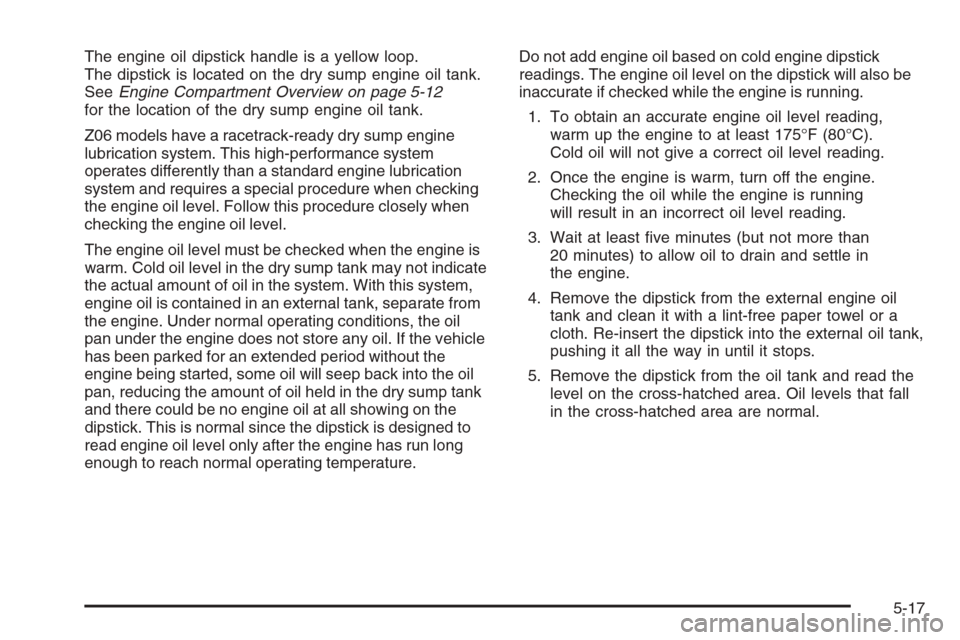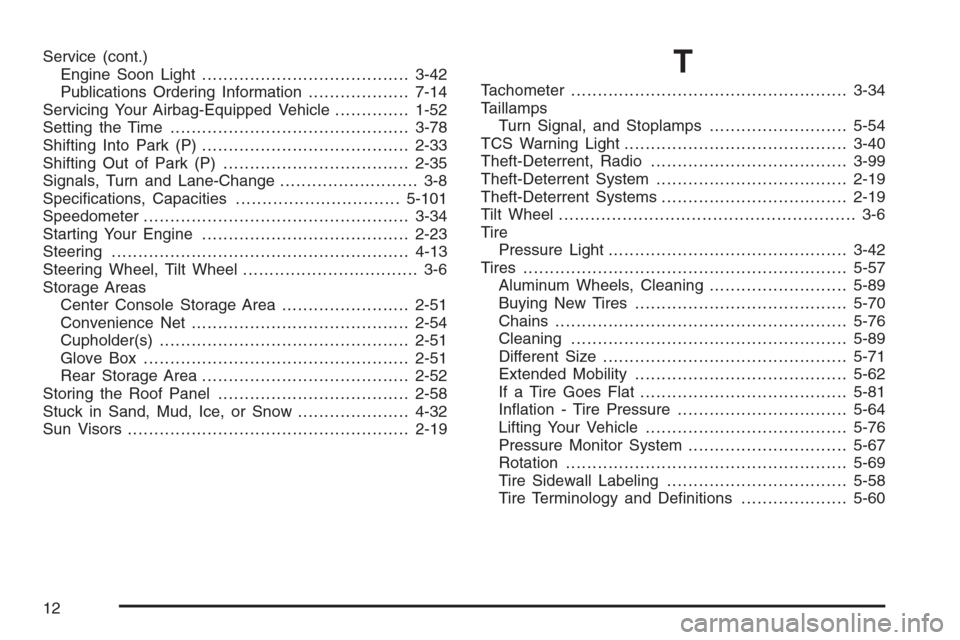Page 293 of 426

The engine oil dipstick handle is a yellow loop.
The dipstick is located on the dry sump engine oil tank.
SeeEngine Compartment Overview on page 5-12
for the location of the dry sump engine oil tank.
Z06 models have a racetrack-ready dry sump engine
lubrication system. This high-performance system
operates differently than a standard engine lubrication
system and requires a special procedure when checking
the engine oil level. Follow this procedure closely when
checking the engine oil level.
The engine oil level must be checked when the engine is
warm. Cold oil level in the dry sump tank may not indicate
the actual amount of oil in the system. With this system,
engine oil is contained in an external tank, separate from
the engine. Under normal operating conditions, the oil
pan under the engine does not store any oil. If the vehicle
has been parked for an extended period without the
engine being started, some oil will seep back into the oil
pan, reducing the amount of oil held in the dry sump tank
and there could be no engine oil at all showing on the
dipstick. This is normal since the dipstick is designed to
read engine oil level only after the engine has run long
enough to reach normal operating temperature.Do not add engine oil based on cold engine dipstick
readings. The engine oil level on the dipstick will also be
inaccurate if checked while the engine is running.
1. To obtain an accurate engine oil level reading,
warm up the engine to at least 175°F (80°C).
Cold oil will not give a correct oil level reading.
2. Once the engine is warm, turn off the engine.
Checking the oil while the engine is running
will result in an incorrect oil level reading.
3. Wait at least �ve minutes (but not more than
20 minutes) to allow oil to drain and settle in
the engine.
4. Remove the dipstick from the external engine oil
tank and clean it with a lint-free paper towel or a
cloth. Re-insert the dipstick into the external oil tank,
pushing it all the way in until it stops.
5. Remove the dipstick from the oil tank and read the
level on the cross-hatched area. Oil levels that fall
in the cross-hatched area are normal.
5-17
Page 343 of 426

Tire Pressure Monitor System
The Tire Pressure Monitor System (TPMS) on your
vehicle, uses radio and sensor technology to check tire
pressure levels. Sensors, mounted on each tire and
wheel assembly, transmit tire pressure readings to a
receiver located in the vehicle. The TPMS sensors
transmit tire pressure readings once every 60 seconds
while the vehicle is being driven and once every
60 minutes when the vehicle is stationary for more than
15 minutes. Using the Driver Information Center (DIC),
tire pressure levels can be viewed by the driver. The
TPMS also uses the DIC to warn the driver when air
pressure, in one or more of the tires, falls below 24 psi
(164 kPa) or is above 42 psi (290 kPa). For additional
information and details about the DIC operation and
displays seeDIC Controls and Displays on page 3-48
andDIC Warnings and Messages on page 3-53.
A low tire pressure warning light also appears on the
instrument panel cluster when a low tire condition exists.
The low tire pressure warning light will be shown each
time the engine is started and stays on until the low tire
condition is corrected.
Each tire, including the spare (if provided), should be
checked monthly when cold and in�ated to the in�ation
pressure recommended by the vehicle manufacturer
on the vehicle placard or tire in�ation pressure label.(If your vehicle has tires of a different size than the size
indicated on the vehicle placard or tire in�ation pressure
label, you should determine the proper in�ation pressure
for those tires.)
As an added safety
feature, your vehicle has
been equipped with a
tire pressure monitoring
system (TPMS) that
illuminates a low tire
pressure telltale when one
or more of your tires is
signi�cantly under-in�ated.
Accordingly, when the low tire pressure telltale
illuminates, you should stop and check your tires as
soon as possible, and in�ate them to the proper
pressure. Driving on a signi�cantly under-in�ated tire
causes the tire to overheat and can lead to tire failure.
Under-in�ation also reduces fuel efficiency and tire
tread life, and may affect the vehicle’s handling
and stopping ability.
Please note that the TPMS is not a substitute for proper
tire maintenance, and it is the driver’s responsibility to
maintain correct tire pressure, even if under-in�ation
has not reached the level to trigger illumination of
the TPMS low tire pressure telltale.
5-67
Page 375 of 426
Fuse Usage
1Transmission Control
Module/Transmission
2 Horn, Alternator Sense
3 Anti-lock Brakes/Real Time Damping
4 Wiper
5 Stoplamps/Back-Up Lamps
6 02 Sensor
7 Battery Main 5
8 Park Lamps
9Powertrain Relay Input/Electronic
Throttle Control
10 Manual Transmission Solenoids
11Engine Control Module/Transmission
Control Module/Easy Key Module
12 Odd Numbered Fuel Injectors
13Electronic Suspension Control
(Option)
14Canister Purge Solenoid,
Mass Air Flow Sensor
15 Air Conditioner Compressor
16 Even Numbered Fuel Injectors
17 Windshield WasherFuse Usage
18 Headlamp Washer
19 Passenger’s Side Low-Beam
20 Fuel Pump
21 Driver’s Side Low-Beam
22 Front Fog Lamp
23 Passenger’s Side High-Beam
24 Driver’s Side High-Beam
J-Style Fuses Usage
25 Cooling Fan
26 Battery Main 3
27 Anti-lock Brake System
28Heating/Ventilation/Air Conditioning
Blower
29 Battery Main 2
30 Starter
31 Audio Ampli�er
32 Blank
33 Battery Main 1
5-99
Page 424 of 426

Service (cont.)
Engine Soon Light.......................................3-42
Publications Ordering Information...................7-14
Servicing Your Airbag-Equipped Vehicle..............1-52
Setting the Time.............................................3-78
Shifting Into Park (P).......................................2-33
Shifting Out of Park (P)...................................2-35
Signals, Turn and Lane-Change.......................... 3-8
Speci�cations, Capacities...............................5-101
Speedometer..................................................3-34
Starting Your Engine.......................................2-23
Steering........................................................4-13
Steering Wheel, Tilt Wheel................................. 3-6
Storage Areas
Center Console Storage Area........................2-51
Convenience Net.........................................2-54
Cupholder(s)...............................................2-51
Glove Box..................................................2-51
Rear Storage Area.......................................2-52
Storing the Roof Panel....................................2-58
Stuck in Sand, Mud, Ice, or Snow.....................4-32
Sun Visors.....................................................2-19T
Tachometer....................................................3-34
Taillamps
Turn Signal, and Stoplamps..........................5-54
TCS Warning Light..........................................3-40
Theft-Deterrent, Radio.....................................3-99
Theft-Deterrent System....................................2-19
Theft-Deterrent Systems...................................2-19
Tilt Wheel........................................................ 3-6
Tire
Pressure Light.............................................3-42
Tires.............................................................5-57
Aluminum Wheels, Cleaning..........................5-89
Buying New Tires........................................5-70
Chains.......................................................5-76
Cleaning....................................................5-89
Different Size..............................................5-71
Extended Mobility........................................5-62
If a Tire Goes Flat.......................................5-81
In�ation - Tire Pressure................................5-64
Lifting Your Vehicle......................................5-76
Pressure Monitor System..............................5-67
Rotation.....................................................5-69
Tire Sidewall Labeling..................................5-58
Tire Terminology and De�nitions....................5-60
12